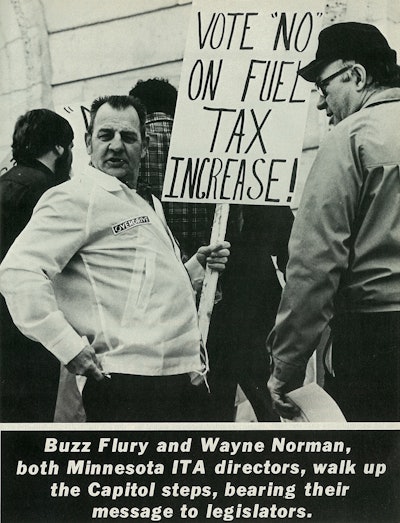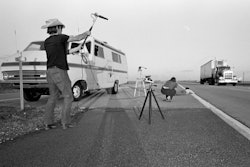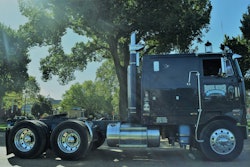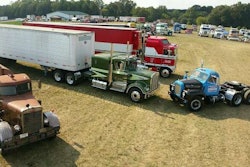Updated September 27, 2021, as part of Overdrive's series of lookbacks attendant to the magazine's 60th anniversary. This story, originally published in 2011, charts broad current in the history of the owner-operator business model in all its complexity decade by decade through the first full decade of this century. Help us finish the history: a decade or two down the road, how will we look back at the 2011-2021 period when it relates to owner-op history? Drop us a comment below this story or reach out directly to Editor Todd Dills.
 Independent Truckers Association state chapter heads Buzz Flury (left) and Wayne Norman protest high taxes on the steps of Minnesota’s Capitol. The photo ran in Overdrive’s July 1979 issue, which reported on trucker strikes in June.
Independent Truckers Association state chapter heads Buzz Flury (left) and Wayne Norman protest high taxes on the steps of Minnesota’s Capitol. The photo ran in Overdrive’s July 1979 issue, which reported on trucker strikes in June.
The owner-operator of yesteryear struggled to prosper amid a complex web of Teamster pressures and over-regulation. Shutdowns and other conflicts lined the highway that led to today’s climate in which the self-employed contractor is integral to the industry and able to operate with much greater independence. From fighting for enhanced freedom to haul in its early days to stressing smart business practices later, Overdrive has championed the owner-operator’s concerns.
When Overdrive launched in 1961, trucking was dominated by the Teamsters union. Even in the unregulated area, where owner-operators and small fleets had hauled commodities deemed exempt from price regulation since the industry’s infancy in the 1930s, unions exerted their organizing pressure. Overdrive founder Mike Parkhurst is said to have been driven to launch the magazine in part by a personal affront chronicled in historian Shane Hamilton’s 2008 book “Trucking Country: The Road to America’s Wal-Mart Economy.”
[Related: Overdrive's first, September 1961 issue in full]
Then owner-operator Parkhurst was at a receiver in Mansfield, Ohio, when “a Teamster organizer informed him that he would have to pay union dues to unload his produce,” Hamilton wrote. Along with the complicated regulatory structure of the Interstate Commerce Commission, the Teamsters, Parkhurst believed, “had ‘strangled the healthy growth of the free enterprise system.’”
The options for owner-operators wishing to haul regulated freight prior to the mid-1950s were limited to finding one of the relatively few regulated carriers who leased owned and operated equipment. Most operators of the time carved a niche in produce markets.









